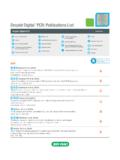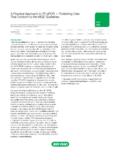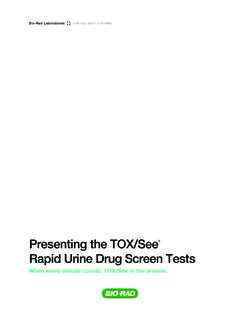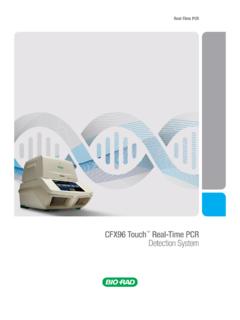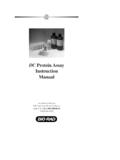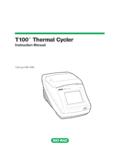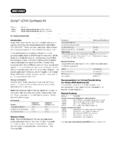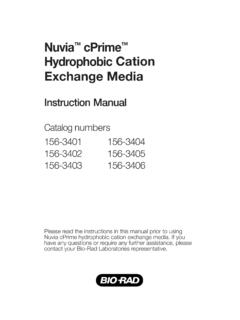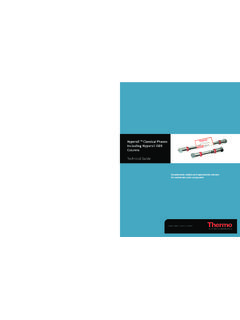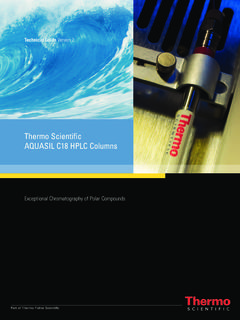Transcription of CHT Ceramic Hydroxyapatite Instruction Manual
1 CHT CeramicHydroxyapatiteInstruction ManualPlease read these instructions prior to using CHT Ceramic Hydroxyapatite . If you have any questions or comments regarding theseinstructions, please contact your local Bio-Rad Laboratories sales of ContentsSection 1 Introduction ..1 Section 2 Product Description .. What is CHT Ceramic Hydroxyapatite ? .. Handling and Packing ..3 Section 3 Chromatography .. CHT Ceramic Hydroxyapatite Mechanism ..4 Table I: CHT Stability in Various Buffers .. Metal Contamination .. Compatibility/Load I: IgG Monoclonal Antibodies .. II: Globular III: IV: Acidic Proteins.
2 4 Regeneration, Sanitization, and Storage ..15 Section 5 Column Packing Handling and Powder for Packing Low-Pressure Process Column Packing Solutions .. Methods .. Axial Compression Packing of Open Columns with Motorized Adjustable Inlet Adaptors .. Flow Packing of Open Columns With Adjustable Adaptors at Less Than 700 cm/hr Flow Rate .. Flow Packing of Open Columns With Adjustable Inlet Adaptors Capable of 700 cm/hr .. Transfer Station Methods .. Compression Packing of Closed Columns With Motorized Adjustable Inlet Adaptors .. Packing Station for Disposal .. Column Qualification.
3 On Column on Column Qualification for Columns With Adjustable Inlet Adaptors .. on Column Qualification for Contained Operating System Pressure-Packed Closed Columns .. on Column Qualification on Columns Used in Purification Campaigns .. the Column for the Purification Application ..30 Section 6 Case Results Custom GE Healthcare Chromaflow 900/200 400 .. Results Prototype Milipore IsoPak IPP350 3: Summary for Packing CHT Type I, 40 4: Summary for Packing CHT Type I, 80 7 Appendices .. to Buffer for Packing 50 cm High Open Columns .. to Buffer for Packing 60 cm High Open Columns.
4 To Buffer for Packing 70 cm High Open Columns .. CHT to Buffer for Packing 90 cm High Open Columns .. to Buffer Guide for Contained Operating System Columns ..38 Section 8 Reference ..39 Section 9 Ordering Information ..401 Section 1 IntroductionCHT Ceramic Hydroxyapatite is a leading purification medium of biomolecules in today s demanding downstream process industry. Itsmixed-mode support offers unique selectivities and often separates biomolecules that appear homogeneous using other chromatographicmethods. The diverse binding capabilities of CHT for host cell proteins, leached protein A, antibody dimmers and aggregates, nucleicacids, and viruses allow its use at any stage from initial capture to final robust properties of CHT Ceramic Hydroxyapatite improve efficiency, yield, and financial value through: Excellent capture at elevated flow rates enabling processing at all scales Large capacity for higher-titer upstream feedstocks Exceptional selectivity allowing for a two-step chromatographic processThis Manual is a guide for the use of CHT as a media support in your purification process.
5 The Manual is organized into four main topics: Product Description Chromatography Regeneration, Sanitization, and Storage Column Packing Protocols Case StudiesThroughout this Manual , we have incorporated recommendations ranging from method scouting and optimization to column packingtechniques that represent feedback from process chromatographers globally. Should you have further questions, contact either your localBio-Rad process chromatography sales representative or the Bio-Rad chromatography technical support department for further assistanceat 2 Product What is CHT Ceramic Hydroxyapatite ?
6 Hydroxyapatite (Ca5(PO4)3OH)2is a form of calcium phosphate used in the chromatographic separation of biomolecules. Sets of fivecalcium doublets (C-sites) and pairs of OH containing phosphate triplets (P-sites) are arranged in a repeating geometric hexagonal structures can be seen in electron micrographs of the material. Space-filling models and repeat structure fromRaman spectroscopy have also been constructed. Hydroxyapatite has unique separation properties and unparalleled selectivity andresolution. It often separates proteins shown to be homogeneous by electrophoretic and other chromatographic techniques.
7 Applicationsof Hydroxyapatite chromatography include the purification of different subclasses of monoclonal and polyclonal antibodies, antibodies thatdiffer in light chain composition, antibody fragments, isozymes, supercoiled DNA from linear duplexes, and single-stranded from double-stranded DNA. CHT Ceramic Hydroxyapatite is a spherical, macroporous form of Hydroxyapatite . It has been sintered at high temperatures to modify itfrom a crystalline to a Ceramic form. The Ceramic material overcomes many of the limitations of traditional crystalline Hydroxyapatite thatprevent its use in industrial-scale applications.
8 The Ceramic material retains the unique separation properties of crystalline Hydroxyapatite ,but can be used reproducibly for many cycles at high flow rates and in large columns. Unlike most other chromatography adsorbents, CHTis both the ligand and the support matrix. Separation protocols originally developed on crystalline Hydroxyapatite can often be transferreddirectly to the Ceramic material with only minor modifications. Two types of CHT Ceramic Hydroxyapatite , Type I and Type II, are available inthree particle sizes, 20, 40, and 80 m. Both types have elution characteristics similar to crystalline Hydroxyapatite , but also have someimportant differences.
9 CHT Type I has a higher protein binding capacity and better capacity for acidic proteins. CHT Type II has a lowerprotein binding capacity but has better resolution of nucleic acids and certain proteins. The Type II material also has a very low affinity foralbumin and is especially suitable for the purification of many species and classes of SpecificationsType I Type IIFunctional groupsCa2+, PO4, OHCa2+, PO4, OHObserved dynamic binding capacitylysozyme (Lys) 25 mg Lys/g CHT mg Lys/g CHTN ominal pore diameter600 800 800 1,000 Maximum backpressure 100 bar (1,500 psi)100 bar (1,500 psi)Nominal mean particle size 20 2, 40 4, and 80 8 m20 2, 40 4, and 80 8 mBulk g/ml CharacteristicsType IType IIObserved dynamic binding capacityIgG25 60 mg IgG/ml CHT* 15 25 mg IgG/ml CHT** Typical linear flow rate range50 1,000 cm/hrpH stability** 14 pH Base stabilityat least 21 months in 1 N NaOH Regeneration500 mM sodium phosphate, pH 71,000 mM trisodium phosphate, pH 11 12 Autoclavability (bulk) 121 C, 20 min in phosphate buffer, pH 7 Sanitization1 2 N NaOHRecommended column M NaOHShelf life (dry, unused material)
10 85 months stored dry, sealed, and at room temperature* 40 m particles, 300 cm/hr, 5 mM sodium phosphate, pH ** 40 m particles, 300 cm/hr, 5 mM sodium phosphate, pH ** For pH , see Section Buffers and Table 1 PurityIn the preparation of Ceramic Hydroxyapatite , use of high-purity raw materials results in low levels of contaminants as determined by ICPmass spectrometry for metal analysis and ion chromatography for General Handling and PackingCHT Ceramic Hydroxyapatite is a rigid support and can operate under high flow rates and pressures. However, excessive physical forcebeyond typical operating conditions can result in bead damage.
